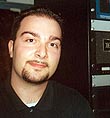|
|
 
|
|
Author
|
Topic: Bi-Amp Phase Issue
|
|
|
|
|
|
|
Steve Guttag
We forgot the crackers Gromit!!!

Posts: 12814
From: Annapolis, MD
Registered: Dec 1999
|
 posted 11-27-2003 08:41 AM
posted 11-27-2003 08:41 AM




Well since you said it is a JBL 4675C 8LF...I'll presume it is indeed bi-amped (there is no 8LF designator for the passive crossover version...in fact it is a 4-Ohm cabinet using lesser drivers).
The hole at 500 (and extending to 800Hz) is not unusual for this speaker. The problem stems from the HF response of the horn and that has also varied over the years (There have been three different versions of the 2360 Horn...with the most significant change happening only a few years ago when it became a nightmare to assemble (2360B)...the throat is in two pieces, the horn is in two pieces and rarely does the gasket match up with the throat/horn.).
If you look up the response on the 2360 horn (there is a white paper on the JBLPro web site: 2360B white paper(pdf)), you will see that the horn has a natural fall off that resembles a 1st order crossover. As a result, if you use a typical Linkwitz-Riley (L-R) 4th order crossover, the HF section will indeed come out a bit on the low side near the crossover point (again 500 and 800Hz are the most affected with a little bit at 400Hz as well since the HF section is not doing its part).
There are several electronic solutions. One is, if your crossover will allow separate tunings, is to use a 3rd order Butterworth crossover on the HF and a 4th order L-R on the LF. Another (and my preferred) approach is to have the LF section crossover slightly higher to help the HF section...you don't want the HF section to crossover lower than 500Hz since the only only really loads down to 400Hz.
The other area you've stumbled on is the time delay. On the 4675 there is an approximately 1.7-1.9msec delay needed for the LF to be time-aligned with the HF (the time will vary depending on the vintage of your speaker, how the horn is mounted and the temp/humidity of the room that day). If you are using L-R crossovers, there should be no phase shift with them so all of the time-alignment must be a combination of mechanical and delay. If you used 3rd order Butterworth filters (the old preferred method before L-R took over) then you would have some phase shift mixed in there to work into the delay computations. The 3rd order Butterworth always seemed to have a smoother transistion, even without the delay, than the L-R on the 4675.
Now as to switching the polarity. It is not necessarily wrong, persay BUT you must be uniform throughout your stage speakers (including subwoofer) on how you use your polarity or you will get that thin and virtual surround-sound feeling. That is, all HF sections must be in phase with each other, all LF sections (and sub) must be in phase with each other. There have been many studies that show that humans can NOT tell the difference between absolute phase (did the sound wave start by pushing or pulling)...even the most untrained ear can tell when two sound sources are not in phase with each other (a comparison).
You will find even the speaker manufacturers use this trick to make fewer passive crossovers. Typically when they design a passive crossover for theatres, if the Large horn (like the 2360) is wired in phase, they will designate that their smaller horn (like the 2380) should be wired out of phase. This is due the the fact that the passive crossover can't have the right delay for both HF sections so they had to choose.
Since you mentioned the QSC 1400 amplifier...one thing to keep in mind...the 1/4" phone jacks on that unit are wired out-of-phase...that is the "tip" is "-" Be sure you are uniform there and if all of the amps are not the same make/model that you are uniform within the rack. A good crossover module for the 1400 is the USL XTA1 by the way...it normally matches pretty good with the JBL 4675...it matches better than with the EV TS-9040.
One last thing to watch out for when swapping polarity at the amps. Make sure the people that sorted out all of the speaker wires did their job (if they are not twisted pairs). Since the low side of most amplifiers is typically ground (earth to you proper English lads)...some sloppy installers will end up having say Center's - connected to Left amp - and so forth. It all works until one amp dies and upon removing that amp two speakers stop working or if you change the phase around.
Steve
| IP: Logged
|
|
|
|
|
|
|
|
|
|
|
|
|
|
All times are Central (GMT -6:00)
|
|
Powered by Infopop Corporation
UBB.classicTM
6.3.1.2
The Film-Tech Forums are designed for various members related to the cinema industry to express their opinions, viewpoints and testimonials on various products, services and events based upon speculation, personal knowledge and factual information through use, therefore all views represented here allow no liability upon the publishers of this web site and the owners of said views assume no liability for any ill will resulting from these postings. The posts made here are for educational as well as entertainment purposes and as such anyone viewing this portion of the website must accept these views as statements of the author of that opinion
and agrees to release the authors from any and all liability.
|

 Home
Home
 Products
Products
 Store
Store
 Forum
Forum
 Warehouse
Warehouse
 Contact Us
Contact Us




 Printer-friendly view of this topic
Printer-friendly view of this topic









![[Smile]](smile.gif)



